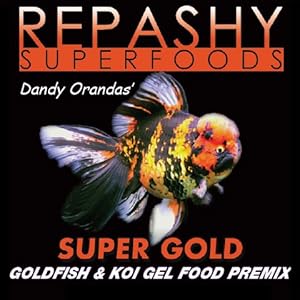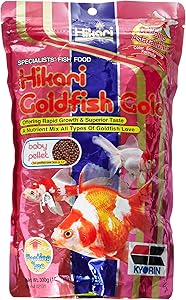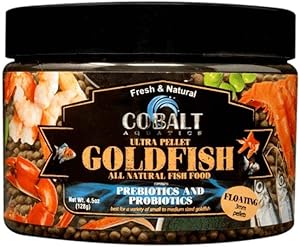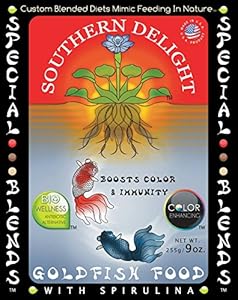Goldfish (Carassius auratus) are one of the most popular fish for the aquarium and pond.
Their beautiful colors, fins and curious personality make them a favorite for everyone from the seasoned aquarist to new fish-keeper. Goldfish have the unfortunate reputation of being indestructible and able to tolerate even the poorest conditions. But this myth is completely false.
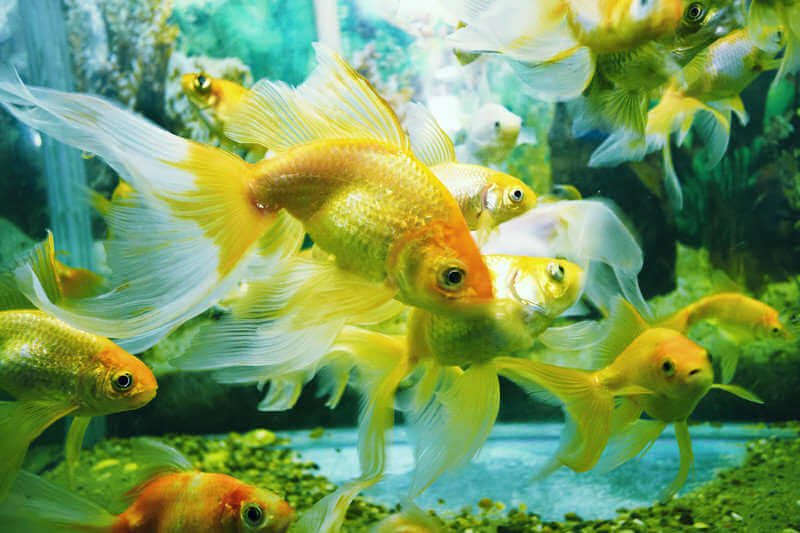
Goldfish require proper care to thrive and remain healthy. Diet is especially important to develop and maintain bright coloration and properly formed fins. A well cared for goldfish can live ten years or longer!
The quality of food you give to your goldfish plays a critical role in keeping your fish active and healthy. Before discussing nutrition and feeding, let’s take a step back in time to learn where goldfish came from. It’s a fascinating story!
In this article
Best Rated Goldfish Foods Reviews
Northfin is a Canadian fish food company. It was started in 2011 by a life-long aquarist who wanted to create a premium fish food.
Northfin Goldfish Formula are slow-sinking pellets. The company offers 2 and 3-mm size pellets for small and large goldfish.
The key ingredients are kelp, krill, herring, sardine and spirulina algae. Vitamins and essential minerals also blended into the formula. The pellets don’t contain synthetic preservatives. The formula will stimulate good coloration and growth.
Northfin uses rosemary oil as an antioxidant, which prevents the decay of the fat and proteins. This food can be fed to goldfish in aquariums and ponds.
Repashy Super Foods is a pet food company located in California.
Repashy uses the gel food method for their goldfish Super Gold product. The food is supplied as a powder. You boil water and mix in the Super Gold formula. The gel will solidify over several hours and can be cut into pieces.
The food contains no preservatives and must be refrigerated. Super Gold contains a variety of unit ingredients including black soldier fly larva meal, krill, spirulina algae, squid and mussel meal. Marigold petal meal supplies color-enhancing carotenoids.
The product is formulated with essential vitamins and trace elements. The soft high-protein gel food can be eaten by large or small fish. Just cut to size.
This sinking food is best for aquarium use, where you can monitor how much is eaten.
New Life Spectrum is known for formulating high-quality fish foods for a variety of aquarium fish.
The small goldfish formula contains krill, whole fish meal seaweed, chlorella algae, scallops along with a balanced vitamin and mineral blend. Beta-carotene will enhance the color of your goldfish. The 1-mm sinking pellet is ideal for any size goldfish.
While pond-keepers lean toward a floating pellet, New Life Spectrum small goldfish formula pellets can be fed in ponds and aquariums. The food contains no preservatives and should be kept sealed and dry to retain freshness.
Pisces Pros, formerly HBH, is a manufacturer of fish foods for a variety of aquarium fish.
Goldfish Flake Frenzy is a low-fiber food made from fish meal, soy flour and wheat germ, wheat starch. The flakes also contain squid and brine shrimp.
You’ll find a variety of vegetable powders have been added including spinach, carrot and red pepper to name a few. The formula includes vitamins and minerals to round out the nutrition.
Flakes can be fed in aquariums and ponds. However, ponds with a fountain or water fall can create too much turbulence for flake foods. This causes the flakes to get too wet and sink very quickly.
Hikari is a pioneering Japanese fish food company. Hikari is well-know for producing specialty goldfish food for demanding goldfish breeders and collectors worldwide.
Goldfish Gold is a 1.7 – 2.0-mm pellet. The small size is perfect for all goldfish.
The floating pellets are for aquarium or pond feeding. The primary ingredients are Fish meal, flaked corn, rice bran, wheat flour, soybean meal, corn gluten meal, and shrimp meal. Astaxanthin stimulates color. The pellets are fortified with vitamins and minerals.
Hikari also makes food specially formulated for fancy goldfish. Hikari Lionhead will stimulate the growth of fish’s “mane”.
Hikari Oranda Gold enhances color and cap growth. Hikari Fancy Goldfish is a professional food for growing out goldfish and developing a bright red color.
Cobalt Aquatics is a fish-focused company comprised of life-long fish enthusiasts.
The goldfish pellets are 100% natural without the use of artificial colors or preservatives. The main ingredients are prawn, anchovies, sardines along with dried seaweed, algae and squid meal. Vitamins and minerals are blended in for a complete goldfish diet. Ultra Goldfish Pellets are 3-mm in size.
They float and are ideal for aquariums and ponds containing any size goldfish. The pellets are also fortified with strains of Bacillus bacteria. The probiotics are thought to improve digestion in the goldfish gut and improve absorption of nutrients.
Southern Delight Fish Foods is a US-based company that manufactures a variety of tropical and goldfish foods.
Fancy Goldfish is a 1.5 mm slow-sinking food. This is a blend of three different pellet formulations.
Color-Pellets contain salmon, herring and wheat meal along with color enhancing beta-carotene, algae meal and shrimp meal. Grow-Pellets (50% protein) contain menhaden, omega-3 fish oil, salmon and herring meal along with vitamins and minerals. Nutri-Pellets contain essential vitamins and minerals along with vegetable meal, alfalfa meal, wheat flour and fish meal.
The idea behind the three-pellet blend is provide all three formulations into one goldfish product. The pellets can be fed to pond goldfish but sinking pellets are favored by aquarists keeping goldfish in aquariums. The small pellets are ideal for any size goldfish.
The history of goldfish
While there are over 250 varieties of goldfish today, it all started with the humble carp.
Over 1000 years ago Chinese fish farmers raised carp for food. The carp were very plain, having a drab olive color and rather ordinary fins. There was nothing special about these fish. It seems every so often a carp developed a bright patch of color. Fish farmers liked the red, yellow and orange fish.
They tossed these fish into separate ponds and kept them as curiosities. As the fish interbred, the genes for bright color were passed down and locked into the genetic code. Chinese fish enthusiasts started cross-breeding for certain colors, trying to develop an attractive-looking fish.
After many generations the fish we know as a basic goldfish came into being. Eventually the Japanese got hold of these fish and further refined the varieties into today’s modern fancy goldfish, like Black Moors, Orandas and Lionheads.
The biology of goldfish
One of the unusual aspects of the goldfish is its stomach. The truth is, it doesn’t have one!
Unlike other fish, goldfish can’t store large amounts of food or begin the digestion process in the stomach. When a goldfish opens its mouth to take a bite, it creates a vacuum that sucks in the food and some water. The water is pumped out through the gills. The food then goes to the back of the mouth where teeth-like structures grind it into smaller pieces.
There are four small teeth on each side of the goldfish’s mouth. That’s right, goldfish have teeth in their throat!
The food now enters the esophagus and passes through to the long intestines.
The intestines are divided into two digestive activities. The first section is called the “midgut.” This is where fats are absorbed from the food.
Next, the food enters the second section or “hindgut.” The main function of the hindgut is the absorption of protein. The hindgut is much smaller in diameter than the midgut.
We’ll see how this stomach-less digestive system affects goldfish feeding later.
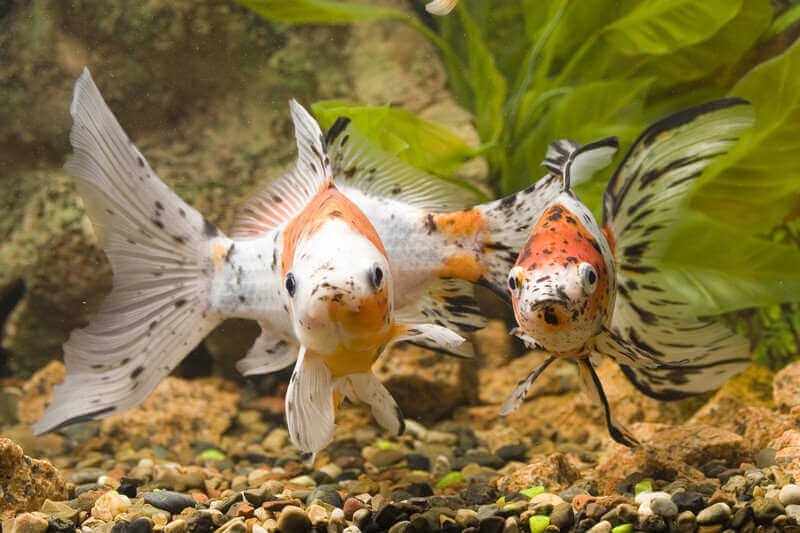
What do goldfish eat?
There have been many children who tried to share their peanut butter and jelly sandwich with their goldfish.
Goldfish living in display tanks at local pubs have been treated to peanuts and beer too!
But this is not the normal diet for goldfish. Goldfish are omnivores.
That means they’ll eat everything from bacteria to worms, algae to plant fragments. They’ll even eat fish eggs and tiny fry if given the chance.
Goldfish raised in outdoor ponds will forage on the bottom, eating worms and insect larvae. They’ll nibble on fuzzy algae growing on plants and rocks. As they sift through mud, goldfish ingest bacteria, tiny crustaceans and other microscopic life.
Many goldfish enthusiasts and professional fish farmers say that the best coloration forms when goldfish are kept in green algae-filled ponds. Obviously, we don’t want an aquarium that looks like green pea soup!
Fortunately, there are many commercially prepared diets especially for goldfish.
Prepared goldfish food
When shopping for goldfish food, the first thing you’ll notice are the many shapes and sizes of food.
Pelleted foods come in a variety of sizes from very small for baby fish to large pellets for full-grown goldfish. But that’s not all.
There are sinking pellets that allow fish to peck at the bottom of the tank. Floating pellets bring goldfish up to the surface to feed. You may even find slow sinking pellets. This type floats for a minute or two then starts to sink as it gets wet.
Granules are a type of small pellet food with a rough surface texture.
Flake foods float on the surface for a while but will sink after they absorb water.
Goldfish sticks are thin, elongated pellets that float at the surface.
Understanding goldfish food ingredients
Fish food manufacturers formulate food products to provide adequate protein, fat, vitamins and minerals so the fish grow and stay healthy.
There are also nutritional regulations that must be met for a food to be labeled as complete and balanced nutrition. All food ingredients must be approved for use in a fish food. Manufacturers must use ingredients from an official list of food ingredients.
Many foods contain supplemental vitamins and minerals. These are added to bring the formula up to recognized levels.
The first few ingredients on a food label are related to protein. A protein level of about 32% has been proven to be sufficient for maintaining growth and vitality.
The truth is, goldfish farms don’t use specialty goldfish food. Fish farmers use generic food pellets that use simple ingredients and a balanced formula of protein, fat, vitamins and minerals.
Some food manufacturers have gotten into a “protein war”, trying to out-bid the competition.
Fish meal is the best source of protein because it contains the most complete amino acid balance. Fish meal is made from marine fish like herring, sardines and tuna. It is considered not fit for human consumption but OK for fish foods. The whole fish are cooked, dried and ground into meal.
Whole fish is a term sometimes used on ingredient lists. There is no official definition of “whole fish” or “fish meal” by government feed officials.
One thing is for sure, no manufacturer is broiling fish fillets and making them into pellets. The fillets must be processed into a fine meal to work in the flaking and pelleting process.
There is also a trend to use plant-based protein ingredients to reduce cost and relieve demand on wild-caught fish.
Corn meal is a low-cost protein substitute associated with poor-quality fish food.
Wheat, soybean and yeast-based meals are digestible by the fish and a source of nutrition.
You may also see algae, mussel meal, blackfly meal on the ingredient list.
Fish oil (fat) is used to add essential fatty acids. It is an energy source for the fish. Typical levels are 7-15%.
Starch is used in pellets to manage the density. More starch puffs up the pellet with air, so it floats.
The ingredient list will also include vitamins and minerals, which are necessary for a complete and balanced goldfish diet.
Fish food gets it color from the ingredients, natural colors like annatto extract or artificial dyes like Red 3.
Fiber adds no nutritional value. Typical levels range from 4-6%.
Fresh and frozen foods
There are many types of food that your goldfish will enjoy that aren’t in the familiar flake and pellet form.
Everyone knows fresh vegetables are packed with nutrition and phytonutrients. Goldfish will graze on uncooked lettuce, spinach and kale, which provide calcium, iron and potassium. Leafy greens are also rich in vitamin C. Raw peas, smashed between the fingers are also a popular food for goldfish.
Citrus slices, like orange, lemon and lime, can be a treat. The tangy flavor stimulates curiosity and the fish will get a little vitamin C too. Yellow squash, cooked or raw, is also a favorite.
If this sounds like a salad you could share with your goldfish, you’re correct.
But there’s also foods you won’t want to eat. Bloodworms, which are really insect larva, are available as frozen cubes or freeze-dried chunks. You’ll also find frozen brine shrimp and freeze-dried insects are readily eaten by your goldfish.
You can even feed your goldfish live earthworms!
Color enhancing goldfish food
Everyone wants their goldfish to be bright and colorful. Carotenoids are fat-soluble pigments that give fish their red, orange and yellow colors. But fish can’t make carotenoids, they must come from their diet.
Marigold petals, pepper meal chlorella algae and krill meal are blended into goldfish food to provide color-enhancing pigments for the fish.
Astaxanthin is a type of carotenoid frequently used in color-enhancing fish food.
Gel foods
Gelatin-based goldfish food is a DIY project you can make at home.
The idea is to create a food that contains no fillers, colors or preservatives. The soft gel can be cut into any size piece.
The food kit comes with gelatin blended with a powder mix of ingredients that include protein, fat and fiber sources along with vitamins, minerals and color enhancers. The powder is dissolved in hot water and poured into ice cube trays or a shallow pan. The gelatin will solidify at room temperature in a few hours.
It can also be cut into strips and dried in an over to make a tougher “jerky” food.
Gel foods must be refrigerated to preserve freshness.
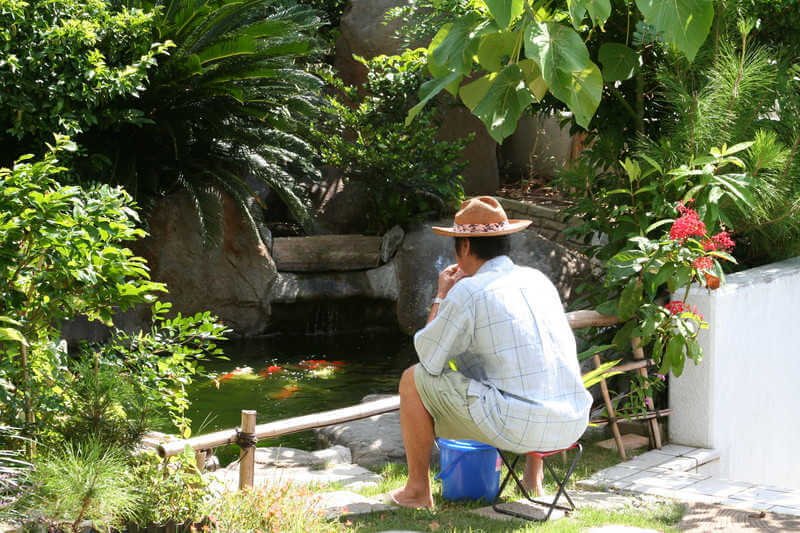
How to feed goldfish
Goldfish are natural foragers. Goldfish continuously explore their pond or aquarium, looking for things to eat.
Since they have no stomach, several small feedings per day are considered ideal for maximum growth. If you want your fish to grow as fast as possible, multiple feedings will get the job done.
A more reasonable approach would be to feed once in the morning and once at the evening.
Flakes and floating pellets will bring fish to the surface of the aquarium or pond.
Pond-keepers prefer floating foods because it makes it easier to see their fish.
Sinking pellets and gel food are best suited for aquariums, where you can watch the fish through the glass.
Stick foods are not a favorite with goldfish keepers. The hard stick is difficult for the goldfish to chew.
Live and frozen foods work great in aquariums too.
Leafy greens can be suspended in the aquariums with a feeding clip. This creates a feeding station where the goldfish can tear off a piece of leaf.
Citrus slices can be thrown into the pond or allowed to float in the aquarium.
Uneaten food will eventually decompose and foul the water. Remove uneaten pellets and flakes after ten minutes.
Once the fish are full, they won’t eat the leftover food.
If you routinely find uneaten food, it’s a sign your adding too much food at one time. Remove uneaten fruit and greens once a day.
Problems with over-feeding
Goldfish will always race to the front of the aquarium when they see you. They’re very smart and will recognize you. After all, you’re the person that gives them food every day. This learned behavior is not a sign that the fish are hungry.
The same can happen with a goldfish pond. While pond fish are very cautious of predators, they’ll get used to seeing you come to the pond. They may even learn what time of day to expect you if your have a feeding routine.
But never be fooled into thinking the fish need food all the time.
There are several things that can go wrong when you over-feed:
- Poor water quality: Uneaten food causes toxic ammonia and nitrite build-up,
- Algae problems: Decaying food releases algae-promoting nutrients into the water,
- Sludge build-up: uneaten foods falls into the gravel, creating a messy sludge layer,
- Disease problems: A dirty sludgy pond or aquarium is the perfect home for fish pathogens,
- Discolored water: The build-up of dissolved organics causes a tea-like discoloration of the water,
- Fat fish: Over-feeding can cause obesity and stress the heart.
What if goldfish won’t eat
A sick or stressed fish may reject food. Internal diseases often go unnoticed until the fish stops eating or shows outward signs of distress. But don’t rush to medicate the fish.
Sometimes it takes a few days for new goldfish to acclimate to their surroundings. Give them a little food to teach them the new routine. Eventually they will feel comfortable and begin to eat.
Switching food can also cause goldfish to reject the new diet. The look, taste and texture of fish food gets imprinted on the fish’s brain as something good to eat.
A new food will have to be “uploaded” into the fish’s instincts before it will feel comfortable with the new taste and feel of the food.
Vacation feeding
It’s OK to miss a feeding if you are away for the day. Your goldfish won’t starve but they’ll be happy to see you when you arrive at home.
But what to do when you are away on a holiday or extended trip?
If you’ve got a dependable friend or relative, teach them how to feed your fish while you’re away. You can even measure out the food and place each day’s feeding in a plastic bag. This eliminates guesswork and makes it easy for the person to feed each day.
The other option is an automatic fish feeder. These devices can be programmed to feed your fish once or several times a day. Some automatic fish feeders allow you control the amount of pellets or flakes added at each feeding. Most auto fish feeders are battery powered, ensuring the feeder works even if there is a power failure.
Closing Thoughts
Today’s goldfish foods provide a complete and balanced diet in flake, pellet and even gel form.
Whether you’re keeping goldfish in an outdoor pond or indoor aquarium, there are many foods to choose from.
Smaller pellets are popular with all sizes of goldfish and are a good all-around staple diet. Fresh and frozen foods add variety to the fish’s diet and are fun to prepare and feed to your pets.
The key to proper goldfish feeding is small portions fed several times a day. Avoid over-feeding and your fish will be content and healthy!

